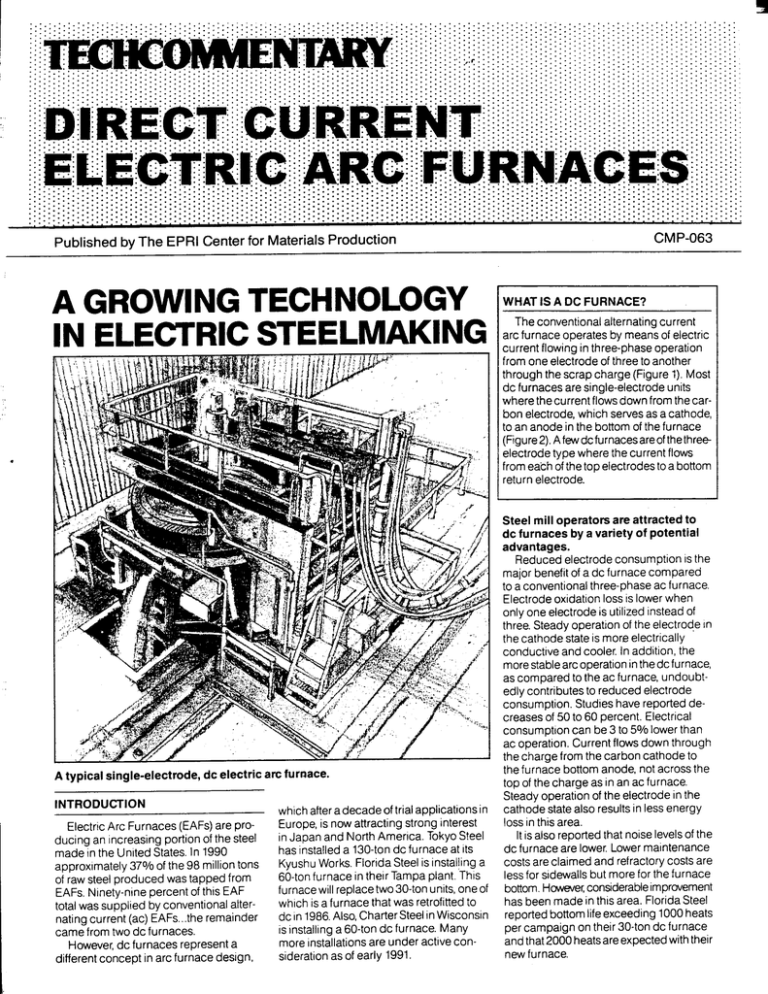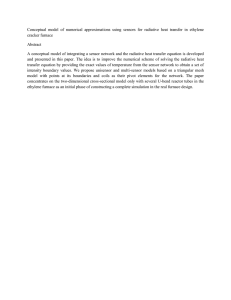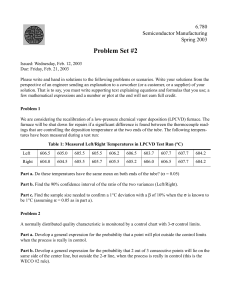
conversion of existing furnaces requires TYPICAL RESULTSFOR SINGLEUtility Advantages
havlng enough space In the transformer ELECTRODE FURNACES
Reduced voltage fluctuatlon lessens
room for the thyristor, reactor,
and auxillary
the problem of fllcker thereby greatly
Florida Steel-Tampa Plant
reduclng or elimlnatlng the need for costly equipment. Also, sufficient space must
This is a 35-ton, 14 MVA, 11 MW meltbe available under the furnace bottom for
VAR compensation.
down dc furnace thatwas converted from
Offsetting the advantages, capltal coststhe secondaryconductor and cooling
equlpment for the bottom electrode.
acto dc. Electrodeconsumptlon provided
for a dc installation are higher than for an
ac system; however, reduced operating costs Bottom electrodedesign has varied with one of the greatest advantages,dropping
from 10 Ibs./billet-tonto 3'/2 Ibs. Inaddimany typesbeing used. (See Figure 3.)
can recoup this difference
Theseincludeconductive refractorieswith tion, the furnace
became simpler and safer
a
copper
external
shell,
and
the
multi-plnto
operate
...
operators
don't change
AC vsDC FURNACES
electrodes as often,and spend less time
type, amanifold having conductive rods
passing through the hearth. Both of these on topof the furnace. Also, very little sidewall
AC Advantages DC Advantages
have
been usedon medium-sized furnaces refractory spraying is
required. EnvironReduced
= Lower
less
than
40
kA.
A
third
type
with
currents
mentally,
while
there
is
little dtfference in
installation
electrode
consists
of
alargediameter
steel
plate
fitted
the
volume
of
dust
generated,
there are
costs
consumption
(single electrode vs
in the furnace
bottom, the steel being waterfewer holes In the roof
No bottom
m Lower lining
cooled where it emergesfrom the furnace. three) whch permits easiercapture of
electrode
wear
Bath stirring
Higher power
rn Better
temperarating for
DATA FOR OPERATING SINGLE-ELECTRODE DC FURNACES
bigger heats
ture
distribution
rn Less noise
us.
Japan
Less network
disturbance
Nucor
Florida Steel TOW
Tokyo Steel
w Lessenergy
Darlington Tampa
Toyohashi Kyushu
consumption
Sept 88 Jan 86
March
85 start-up
Jan
89
Despite
the many
of
dc diameter Shell
7.0m
4.57madvantages
3.8m
3.8m
operation, it is only recently that thesecapacity Rated
32t
32t
3ot
13Ot
furnaces have gained a foothold. The
Tapping
weights
30t20-1 130-35t
30-35t
30-35t
development of low-cost semiconductor
Transformer primary
was the needed
breakthrough.
22kV rectifiers 22kV
13.8kV
13.8kV
voltage
Max melting power
11.5 MW MW11
15MW
2 x30MW
electrode
current
Max
37 kA
40kA
100-12okA
42kA
DC ARC FURNACEDESIGN
16"diameter
Electrode
18"
18"
28 I'
FEATURES
Electrode regulating
hydraulic
hydraulic
hydraulic
hydraulicsystem
Essentially, the equipment neededfor dc
Roof
wtr-cooled
wtr-cooled
wtrcooled wtr-cooled
melting has the same configuration as
Sidewall
wtr-cooled
wtr-cooled
wtr-cooled
wtrcooled
that of a conventional ac furnace shown in
Bottom
electrode
air-cooled
air-cooled
air-cooled
air-cooled
Figure 1. Theexceptions are theaddition
ConversionlNew
of the bottom electrode (anode), a dc
Conversion
installation
Conversion
Conversion
New
reactor, and a thyristor rectifier
(Figure 2.)
all ofwhich add to the cost of a dc furnace.
High Voltage
n
Figure 7. Conventional ac electric arc furnace.
Figure 2. Layout of dc arc furnace.
’
speclfcally forsafety. Advantagesclantled
for the furnace are:
50% reductlon In electrode consumptlon
rn 5 to 10% reduction in power
consumption
rn Greatly reduced refractory
ccnsumption
Uniform melting
Reduction of flicker leveland flicker
frequency byhalf
Production of 23 heatdday and 75,000
MT/mo-rated capacity-were achieved
TOPY-Toyohashi Works (Japan)
early in 1990. Visitorsto the operation conThis furnace is veryclose in size and
firm that veryimpressive results are
being
power to the FloridaSteel furnace. Following
attained wlththis furnace.
two yearsof operation, TOPY published
results showing cost reductions of 53% in
electrode consumption, 5% in power,
and 30% in refractorywear. Together these NEW DC FURNACESIN THE UNITED
savings add up to $6.00/ton. Electrode
STATES
consumption has been about 3.2 IbsAon,
As of early 1991,there are two newdc
and bottom life about 330 heats per
arc furnaces being installed in the United
campaign. Further improvements are
States. Each features single-electrode
a
anticipated, with particular attention to
increasing the lifeof the bottom electrode. furnace. FloridaSteel,at their Tampa plant,
is replacing two existing30-ton furnaces
The expectation is that payback on this
conversion to dc will be less than 3 years. with one 17 ft. diameter 60-ton furnace
powered by a37 MVA transformer. Output
of the new furnace will be one 35-ton heat
Tokyo Steel-Kyushu Works (Japan)
This furnace,with a capacity of 130 tons about every 45 minutes.Electrode consumptron of 3.5 Ibs./billetton is expected,
and 60MVA, is the largest operating
single-electrodedc steelmaking furnace
as which compares to 10 Ibs. on similar ac
furnaces. No change is expected in elecof 1990. It uses the maximum diameter of
trical consumption.
commercially available electrodes, 28”,
Charter Steel,at thew Saukville,
permitting a current of about 100 kA. This
Wisconsln plant, is installrng a60-ton, 17 ft.
furnace, which began operation in Sepdiameter shellfurnace powered with a
tember 1989, has
a rated capacity of 1 miillon
tonslyear. Anticipated savingsof
$15 perton 42.3 MVAtransformer.Two355 k A , 12-pulse
rectifiers willprovide the dc current.
over ac furnace operation translates to a
payback on the
added cost of dc in lessthan Electrode diameter willbe 24”. Initial output of the furnace will be 250,000NT/year,
two years. Features
of the furnaceinclude
uniform melting with the central electrode, and start-up is planned for June 1991.
simple arrangement with the single mount
and single secondary conductor, and an
air-cooled bottom electrode designed
fumes. Basedon three year’s operatlon,
the declslon was made to replace the
current furnace and a sister ac furnace of
the same slze withone 60-ton, 37 MVA
dc arc furnace.One feature of the new furnace will be the use of a 12-pulserectifier
compared to the 6-pulse unit on the
existing dc furnace. This will eliminate the
lower level harmonics (7,9, 11) which will
be beneflcial in reducing line disturbance.
I
Bottom
Electrode
U
0
Conductwe
Relractories
Conductor
THREE-ELECTRODE DCARC
FURNACES
While mostdc arc furnace lnstallatlons
employ a slngle, central electrode, 82-ton
an
capaclty, 83 MVA dlrect current threeelectrode arc furnace has been operating
at SME in Trith St. Leger, France since
December 1985. Design of this furnace is
based on development work
carried out
by the French SteelIndustry Research
Institute(IRSID).Eachofthethreetopelectrodes is matched to a bottom electrode In
the hearth. Addltionally, each electrode has
its own transformer-rectifier-reactor
assembly. The top electrodes 22”
are diameter, and each can draw amaximum of
40 kA. Lower current intensity in the electrodes and the fact that
the arc IS directed
toward the center
of the furnace (instead
of at the walls in an ac furnace) has resulted
in a reduction of electrode consumption
and wall wear that approximates that
experlenced with singleelectrode dc furnaces.
Experienceduringthe first half of 1990
puts
electrode consumption at 2.4 Ibs./ton.
Bottom life hasreached about 1500 heats
with an expectation of reaching 2000.
ESTIMATEDCOMPARATIVE CAPITAL
COSTS FOR A 100”N FURNACE TO
PRODUCE 700,000 TONSNR:
AC
DC
$million
$million
Furnace i d
electncs
Burners
Reactiveenergy
compensation
Total Cost
6.3
0.5
9.5
not needed
2.s (65 MVAR) 1.0(30MVAR)
9.6
10.5
Operabng Cost
(less scrap)
W5iton
Payback on the additional
$29Ron
less than
six months
investment
THREE-ELECTRODE
SINGLE-ELECTRODE
AC
FURNACE
FURNACE
DC
U
0
Multi-Pin
Metallic
Conductor
Single Piece
Metallic
1
Figure 3. Bottom electrode designs for dc furnaces.
I
Uneven Heat Dislrlbutinm
Pattern in &Phase AC Furnace.
Unlform Heat Distribution From
Central. VerlicsI Arc in DC Furrucs.
~~
Figure 4. Temperature Distribution-dc furnace operation,
particularly witha single electrode produces improved
heat distribution. The
ac furnace has hot spots
on the furnace walls adjacent to the three electrodes typically
causing high sidewall refractory wear. The dc
furnace
produces a uniform heat from a central arc. The resulting
temperature profile also promotes convection stirring
as anadded benefit.
Kawasakl Steel has installedfurnace
a
with one topand three bottom electrodes
whlch started-upIn December 1990.
Another furnace hasbeen ordered by
Nakayami Steel.
’
, I
REFERENCES
1. CMP Report 86-8, DC Arc Furnace Melting Performance Analysis
2. Design, Installationand Operation of the World’s First Direct Current Arc Furnace
in Steel Mill Service-l&SM, May 1986
.. .
. .
FUTURE OF DC ARC FURNACES
3. Single-ElectrodeDC Furnace at Florida Steel-l&SE. January 1987
Whlle it is not clear thatdc arc furnaces
are the “waveof the future”for steel
melting, results obtained in the past five
years with furnaces ranging in size from 30
to 130-tonscapacity have been very
impressive. Interestin these furnaces is
high on the part of many domestic steelto assume that
makers, and it is reasonable
many more dc furnaces will be installed.
Today’s electrode technology limits
diameter to a maximum of 28 inches, allowing a dc current of approximately 100 kA,
and restricting power to 75 MVA for a
single electrode furnace. This Inturn limits
the size ofsuch afurnace to well under
the 200-tons capacity of current large ac
furnaces: Perhaps the three-electrodedc
furnaceswill fill thisgap. Another possibility
is to develop larger diameter electrodes.
At present, the dc furnace offers a potential
for substantial savingsto the steelmaking
industry In ranges
up to 75 MVA.Utilitiescan
look forwardto fewer electrical disturbances
in the powergrid.
4. The DC ArcFurnace of Societe Metallurgiguede I‘Escant: FirstMonth of
Operation-ME, June 1987
5. DC Arc Furnaces-U.I.E. 11, March 7, 1988
6. Technical and Economic Aspects Regardingthe Practical Applications of a DC
Electric Arc Furnace-H. Essman and Dieter Grumberg of Brown Boveri
7. Mini-millsTestthe DC Route-MBM Supplement, October, 1989
8. Single Electrode DC Arc Furnace Operation at Florida Steel CorporationD. Meredity, Florida Steel Corp.and s. E. Stenkbvest, ASEA Metallurgy
9. Start-up of the World‘s Largest DC Arc Furnace
at SME-AIM€ Advanced
Technology Symposium, October 5,1989
10. Technological AdvantagesOffered by Direct Current Arc Furnaces-International
Steel Technology,December 1988
11. Economics and Technology of Electric Arc Furnace, CMP TechCommentary,
CM P-059
i
12. Electric Arc Furnace Steelmaking, CMP TechCommentary, CMP
Vol. 1, No. 3
13. Understanding Electric Arc Furnace Operationsfor Steel Production, CMP
TechCommentary, CMP Vol. 3, No. 2
The Center forMaterials Production
The ElectricPower Research Institute
(CMP) is an R&Dapplicationscenter
(EPRI) conducts technical
a
research
funded by the Electric Power Research
US.
and development program for the
Institute and operated
by Carnegie
electric utility industry. EPRl promotes
Mellon ResearchInstitute of Carnegie
the developmentof new and improved
is to
technologies to help the utility industry Mellon University. CMP’s goal
meet present and future electric energy develop and transfertechnical information that addresses
the concerns of
needs in environmentallyand ecoU.S. materials producing companies
nomically acceptableways. EPRl
conducts research on all aspects of use, regarding productivity, quality, energy
efficiency, and the environment.
including fuels, generation, delivery,
energy management and conservation,
EPRI
environmental effects, and energy
Robert Jeff ress
analysis.
Manager, Industrial Program
CMP
Joseph E. Goodwill
Director
This Techcommentarywas prepared by
Dick Hurd and John
Kollar, CMP. Technical
review wasprovided by Robert J. Schmitt,
ManagerofTechnicalProjects,
and
.
Joseph E. Goodwill, Director,CMP.
Applicable SIC Codes: 3312,3313,3315,3316,3317
@Copyright 1991 Electric Power Research
Institute,
Inc.
All rights
reserved
Materials
Production
Printed 1/91
Carnegie Mellon
Research Institute
4400 Fifth Avenue
Pittsburgh, PA 15213-2683
412-268-3243
LEGAL NOTICE
This Techcommentary was prepared
and sponsored bythe Center for
Materials Production (CMP). Neither
members of CMP or any
person acting
on their behalf: (a) makes anywarranty
expressed orimplied with respect
to the
use of anyinformation, apparatus,
method, or processdisclosed in this
Techcommentary or thatsuch use
may not infringeprivatelyownedrights;
or (b) assumes anyliabilities with
respect to the use of, or for damages resultingfrom theuseof,
any information,
apparatus, method, or process disclosed
in this TechCommentary.


